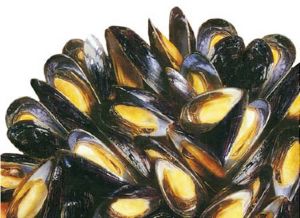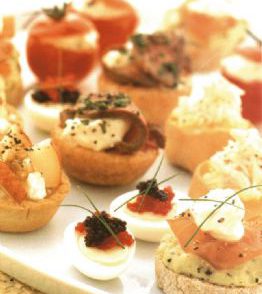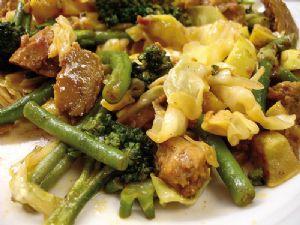If there’s one
thing that gets up my nose at this time of the year, it’s people droning on
about the romance of heading into the great outdoors with a simple, rustic
lunch. The journalist Christopher Hitchens once wrote that picnicking-along
with lobster, champagne and something else that has no place for discussion in
a family publication such as this one-is one of the most over-rated things in
the world, and, under certain circumstances, I’m inclined to agree with him.
The thing is, if it’s too nice outside to eat all of your meals indoors,
sometimes you’ll want to venture farther than the front garden. But the
delights of a picnic can quickly fade when you’ve been reduced to tearing a
huge ciabatta up with your hands and eating tomatoes whole, like apples; your
white linen outfit covered in breadcrumbs, pecorino smears, rogue pips and
voracious ants.
Far better, then, to spend half an hour or so thinking about what you
want to take with you, avoiding unnecessary hassles and unpleasant surprises
such as droopy sandwiches and warm, limp salads. Pack your picnic well and
you’ll be able to eat on the fly without sprouting any grey hairs-or having to
spend hours dealing with countless Tupperware containers.
Forgo hefty breads for something easily manageable, like soft piadine,
which can be filled, rolled, refrigerated and then wrapped in tinfoil to keep
cool while you head to your picnic spot. When you’re thinking of fillings,
avoid dairy products (cheese will get sweaty, unpleasantly soft and tangy) and
egg-based mixes like mayonnaise. Stick to vegetable pastes like tomato or
pepper puree, or olives blitzed with oil and garlic in a blender.
Crunchy vegetables, like slices of peeled cucumber, thinly julienned
carrots and slivers of white cabbage make good fillings, as do lean meats and
cooked fish (like tuna or salmon). If you want to take tomato-and you should
consider it: with a little salt and pepper it’s the perfect picnic foodstuff-keep
it separate from your sandwiches until you arrive, as it will dampen even the
hardiest bread.
Avoid creamy or very watery dressings on salads. Instead, take 50ml of
any type of vinegar (balsamic works very well), 30 ml of oil (such as olive
oil) and a teaspoon or so of smooth mustard; mix them together with either a
whisk or a hand blender and you will have a nice, thick dressing that can be
siphoned into a bottle and judiciously drizzled over your salad when you are
ready to eat. Adding a teaspoon or so of pesto to this dressing is also
recommended.
In terms of the salads themselves, stick to robust vegetables-cubes of
beetroot, pieces of red onion, fresh parsley, thinly sliced fennel, grated
carrot, beans, corn, peas and pearl barley. Think hardy. Lettuce, cucumber and
tomato are great but will suffer from transportation. On this page is a recipe
for a tried-and-tested pearl barley salad that barely takes any preparation, is
robust, and will fill you up after a long walk.
Drinking red wine in the sunshine is great fun, as long as you’re
traveling by foot. Falling asleep on a picnic blanket at lunchtime and waking
up at 9pm-hung-over,
sunburnt, mosquito-bitten and menaced by porcupines-is no fun at all. Mix a
flask of wine, Sprite and fruit juice (half wine, 25 percent each of the other
two) and add some ice-cubes. Pack twice as much water as you do alcohol, and be
sure to drink it.
Finally, consider a picnic basket. This is undoubtedly a matter of
personal preference. As an Englishman abroad, I think it’s an essential item,
like a folding bicycle or a hip-flask, but I understand that not everyone
shares this view. However, it’s a handy place to store a blanket, crockery and
cutlery, containers of food, and more-and many even come with insulated
cool-bags to keep your food fresh and your drink ice-cold.
Pearl
barley and fresh vegetable salad (Serves two)
120g pearl barley (orzo perlato)
1 red onion, peeled
Half of a large bulb of fennel
2 carrots, peeled and trimmed
50g frozen peas
30 fresh parsley, chopped
1 small handful cashew nuts, roughly chopped
1 dried red chili
2 bay leaves
1 stock cube (delicato or vegetable)
10g butter
Half of a lemon
Salt and pepper
Place the barley in a saucepan with the bay leaves, butter, dried red
chili, and stock cube. Cover with water
and bring to the boil over a medium heat. Then, partially cover the pan, reduce
to a simmer and cook for 25 minutes.
Meanwhile, trim and chop the fennel finely, first discarding all green
pieces and fine fronds. Add the fennel to the pan, with the peas; bring back to
the boil, and cook for 5 minutes more.
Drain the barley and vegetables and remove the bay leaves and chili.
Rinse under cool water and then leave to dry in a colander.
Grate the carrot into a bowl. Chop the onion finely and add. Stir in the
cashew nuts and parsley. Add the cooled barley and vegetables. Squeeze the
lemon juice over all and season to taste.
Ingredient of the fortnight: Salsiccia
fresca
Specifically, the local variety of fresh sausage, very meaty and lightly
seasoned. Many varieties are available, in various stages of cured-ness, but
the fresca is by far the most versatile.
Tuscan sausages bear very little resemblance to the forlorn, grey-pink
cylinders of extruded meat foam that pass for sausages in the UK;
typically, the lean meat content is around 70 percent and very little cereal is
used to bulk the sausage out. This is obvious when the sausages are cooked
whole: there is virtually no shrinkage and, well, they taste like good-quality
pork.
Eaten whole-from the grill or cooked in the oven for 40 minutes or so
(pricked with a fork to stop them from splitting)-the sausages are delicious,
but they really perform well in other dishes. Split open the skin, pull out the
meat, and crumble it gently into a pan, before adding chili, garlic, lemon
juice, a little fresh thyme and a chopped red onion; serve with broad pieces of
pasta (like mafalda corta) and a little butter.
Alternatively, form the filling into meatballs and use them as you would
forcemeat balls in stews or pies, or mix it with cooked vegetables or rice to
use as stuffing for tomatoes or courgettes (zucchini).







